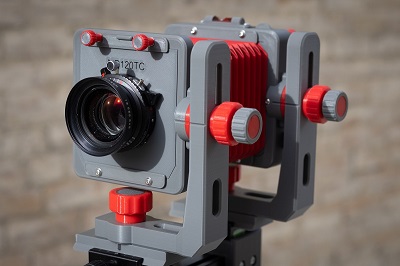MP120TC (Version1, December 2022)

The MP120TC is a 120 film technical camera designed by Kent Williams in 2022. It has full tilt/shift/swing/rise/fall movements on both the front and rear standards to enable full control of focus plane and geometry just like a large format view camera. It uses Graflok 23 compatible roll film backs for convenience, and the parts that move most utilize off-the-shelf metal parts for durability, smoothness, and precision. You can even build your own bellows for it if you're up to the task. The camera will work with any large format lens in shutter as long as there's enough image circle and you have the proper rail/bellows length combination. Most of the camera is 3D printed, so when parts wear out, you just print another!
License
The MP120TC is provided to the community using a Creative Commons Attribution-NonCommercial 4.0 license This means you can Share or Adapt/Remix it, as long as you provide attribution and don't sell the design. See this page for more details.
Website
The MP120TC also has its own website, which can be found here: MP120TC Website
Why I Designed The MP120TC
In 2021 I got my first 3D printer. I'd been designing things and having them printed at outlets like Shapeways and Xometry for several years. With this new 3D printer in my possession I decided to print and build an open source 120 film technical camera I had found online. It looked nice in pictures and all the files were available, so I was pretty sure it'd work ... or so I thought.
Once I started printing parts, I had a realization that the camera had several pretty important faults. The idea was cool, and it would look nice on the shelf, but it wouldn't really be usable. I first attempted to modify the existing design and immediately ran into more problems, since many design decisions were built into the models that conflicted with the idea of making a usable camera. I came to the realization that it'd probably be better if I started from scratch and designed my own.
How It Got Its Name
Early on in my designing process I had discovered a project called the MPCNC, which stands for "Mostly (3D) Printed CNC", which is a CNC router you can build using a combination of 3D printed parts and off-the-shelf hardware. The idea is to construct the router using mostly 3D printed parts, and augment those parts with hardware that is better suited in only those places where the hardware is better for the task. I think this is a pretty clever idea, and I adopted it for my 3D printed technical camera. It is mostly 3D printed, augmented with parts where 3D printing would be less effective. It's a 120 technical camera, so I named it the Mostly Printed 120 Technical Camera, or MP120TC for short.
120 Film Instead of 4x5
There are several reasons I chose 120 film, specifically 6x7cm, over 4x5 inch film:
- There are numerous 4x5 3D printable camera designs already available
- 4x5 inch film is considerably more expensive per shot
- 4x5 inch film is considerably less convenient and much more cumbersome to carry
- 4x5 inch film is much more expensive to develop if you send it to a lab
- 4x5 inch film is a lot more difficult to scan
- 6x7cm image quality is very high and can almost approach the quality of 4x5 inch film
- 120 film is much easier to get and is much less expensive
- If you want to use a lab to process your film, 120 film is much less expensive
- Scanning 120 film is a lot easier and less expensive
- 120 film backs are readily available, made by Mamiya, Graflex, or Horseman
6x7 By Default, 6x9 Optional
By default, the MP120TC is a 6x7cm camera that employs the Graflok 23 roll film mount (sometimes called Graflok Mini). Because Graflok 23 was built to handle it, the MP120TC can also support 6x9 if desired. I've been asked why I chose 6x7 as the default when I could have gone with 6x9 instead. Here are the reasons I've chosen 6x7cm by default.
6x7 film backs are much more plentiful. The most common 6x9 film backs are from Graflex and Horseman, while with 6x7 you can use Mamiya RB-67 backs, Graflex, and Horseman. While the Horseman backs are really nice, they're not very easy to get. Graflex backs are pretty common, but are not as well made as Mamiya and Horseman, nor do they hold film as flat as Mamiya and Horseman backs.
For the 6x7 size, there are more options available for the ground glass, especially from Rick Oleson Bright Screens. In 6x7 size, you can get screens with many different focusing aids (splits, microprisms, etc.) and lines for other formats. With 6x9 you can only get plain focusing screens, cut down from 4x5 inch screens.
As you can see, there aren't many reasons, but the film back availability is a pretty important one. Having said that, those who wish to go for 6x9 can totally do so - the files are included.